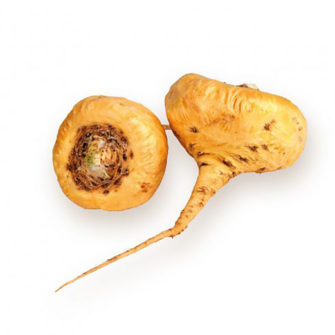Maca, sometimes referred to as Peruvian ginseng, is a cruciferous vegetable related to broccoli, cauliflower, cabbage, and kale. It is native to the high plateaus of the Peruvian Andes mountain range where the Andean people have cultivated it for more than 2,000 years. In Peru, maca is consumed as a fermented drink or porridge but it is also used as a natural medicine to treat respiratory conditions and rheumatic disease.
The demand for maca products has grown in recent years, likely because of claims that the plant can promote libido and fertility in men.
The most common form is maca flour, which is a baking flour ground from the hard, dried roots. Maca flour (powder) is a relatively inexpensive bulk commodity, similar to wheat flour or potato flour. The supplement industry uses both the dry roots and maca flour for different types of concentrated extracts. Another common form is maca processed by gelatinization. Since the raw form of maca is difficult to digest, the gelatinized form is created through an extrusion process that separates and removes the tough fiber from the roots.
This versatile adaptogenic herb helps the body adapt and deal with different stressors so you can live a well-balanced life. Adaptogenic herbs (or adaptogens) are defined as agents that support the body’s ability to accommodate varying physical and emotional stresses.
Used both nutritionally and medicinally, Maca grows wild in Peru, Bolivia, Paraguay, and Argentina, but has primarily been cultivated in the highlands of the Peruvian Andes.
Maca Uses
- Increase libido
- Fertility in males
- Improved mood and energy
- May help relieve symptoms of menopause
- May help preserve cognitive function
- May benefit benign prostatic hyperplasia (BPH)
- May benefit skin health
Maca helps to balance hormone levels in women as well, helping with conditions like PMS, PCOS and oestrogen dominance, as well as improve fertility, libido and stress management. Maca can also been used during menopause to reduce symptoms of hormonal transitions like hot flushes, mood fluctuations, anxiety and to return inner harmony and balance to the body.
Side Effects of Maca
Studies show that maca is generally safe and there are no known adverse side effects associated with its use. But there is no safety data concerning its use during pregnancy or breastfeeding.
Contraindications Related to Maca
Peru, Bolivia, Paraguay, and Argentina
Origins of Maca
Maca comes from the Peruvian Central Andes and is still the locattion where the best quality and most effective Maca is still cultivated. Although it can be grown successfully in other climates, the medicinal root of Maca is neither as large or as potent as when grown in the high Andes.
My Favorites
- No Favorites Yet

